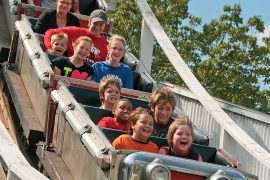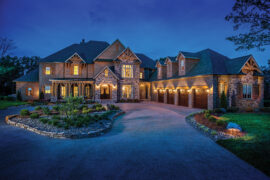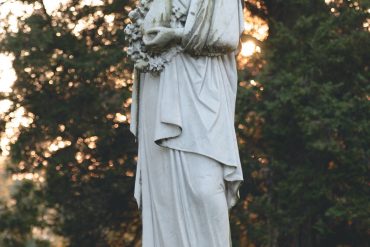By James E. Casto
HQ 57 | WINTER/SPRING 2006
“Banker, Pioneer, Builder of City”— that’s how a page-one headline in The Herald-Dispatch described Huntington’s James Lewis Caldwell when he died on Oct. 18, 1923.
J.L. Caldwell was all that and more. Much more.
He was one of the first to see the possibilities of the rich coalfields of southern West Virginia and worked tirelessly to tap that vast natural wealth. He built Huntington’s first street railway and its accompanying electric lighting system. He invested in countless other business ventures in the city’s early years and was long active in Republican politics.
Caldwell was born in 1846 at Elizabeth in Wirt County, then, of course, still part of Virginia. The Caldwell family hailed from Ohio and young Caldwell was educated in the schools of Meigs County, Ohio. There, though only 17 years old, he enlisted in the Union Army as a member of Company F of the 60th Ohio Infantry.
The young soldier served with distinction, taking part in the battles of the Wilderness, Cold Harbor and Petersburg. Proud of his time in uniform, he later would serve as West Virginia commander of the Grand Army of the Republic, the once vast organization of Union Army veterans.
At war’s end, Caldwell briefly represented an insurance company in Wheeling, traveling far and wide in the state. In St. Albans, he met and courted Mary O’Bannon Smith and they soon wed. They would be husband and wife for 52 years.
The young couple first lived in Wheeling, then moved to Guyandotte, as did Mary’s parents. In Guyandotte, Caldwell operated a small hardware business with his father-in-law, Nicholas Smith. The two men also busied themselves in the timber business, which at that time saw thousands of trees felled and then, at periods of high water, floated down the Guyandotte River to the Ohio River.
Nimble-footed loggers would be astride the makeshift rafts of logs, endeavoring to guide them and keep them moving freely, without jamming up. Frequently, they would have to jump from one moving log to another. It was difficult and dangerous work.
Local legend tells of how one day an agitated Caldwell, safe on shore, loudly called out to his men on the logs, urging them to “ride ’em!” At which point, one logger is said to have come ashore and said, “Why don’t you ride ’em, Mr. Caldwell?”
Presumably, that was an offer Caldwell thought best to refuse.
When rail tycoon Collis P. Huntington arrived on the scene and founded his new town of Huntington, Caldwell moved quickly to take advantage of the opportunities this presented. In 1884, he organized the First National Bank of Huntington. Caldwell became the bank’s president, a post he would continue to hold until his death, nearly 40 years later.
In 1887, Caldwell and his wife moved from their home on Main Street in Guyandotte to a handsome new Queen Anne-style home built for them at Third Avenue and 12th Street, then a fashionable address in the rapidly growing Huntington.
In 1889, Caldwell had a rail route surveyed to the Logan coalfields and offered it to the Norfolk & Western Railway, which apparently gave it careful consideration but ultimately declined. Undiscouraged, Caldwell himself organized the Guyandotte Valley Railway Co. and, after extensive negotiations, came to terms with the Chesapeake & Ohio Railway in constructing and operating the line, built first to Midkiff in Lincoln County and then beyond.
Caldwell and his various partners owned thousands of acres of timber and coal land in southern West Virginia.
He organized Huntington’s Consolidated Light & Railway Co. in 1892, later selling it to Senator Johnson L. Camden of Parkersburg, who incorporated it into his Camden Interstate Railway Co.
He constructed the Caldwell Building at Fourth Avenue and Ninth Street, one of Huntington’s earliest business buildings, and he largely financed erection of the Hotel Frederick. He played a key role in the creation of Central City, located just west of Huntington, and induced a number of industries to locate there.
In 1914, with Caldwell as president, the First National Bank built itself an impressive new 12-story building at Fourth Avenue and 10th Street. Later, after a 1924 merger with the Huntington National Bank, the newly created First Huntington National Bank added a major addition that extended the building all the way back to the alley. (Today, it takes a careful eye to detect where the original building stops and the addition begins.)
Caldwell was 77 when he died of pneumonia. Friends and family said he had been in declining health for some time. His daily visits to his desk at the bank had become rare events.
J.L. and Mary Caldwell had two daughters — Ouida and Ida — and four sons — Nicholas Smith Caldwell, James Lewis Caldwell Jr., George Jackson Caldwell and Foree Dabney Caldwell. Mary Caldwell was 76 years old when she died in 1927.
Banking clearly was in the Caldwell family blood. J.L. Caldwell’s son, Foree Dabney Caldwell, served as a director of the First Huntington National Bank from 1924 until his death in 1936, and grandson Theodore J.S. Caldwell, who died in 2001 at age 80, was a former chairman of the bank board.
“But J.L. Caldwell’s legacy is measured in more than dollars and cents,” says Huntington businesswoman Liza Caldwell, his great-granddaughter. “He instilled in his children — and they passed on — a respect for heritage and history that’s still very evident today. All of us owe him a debt of gratitude for that great gift.”





